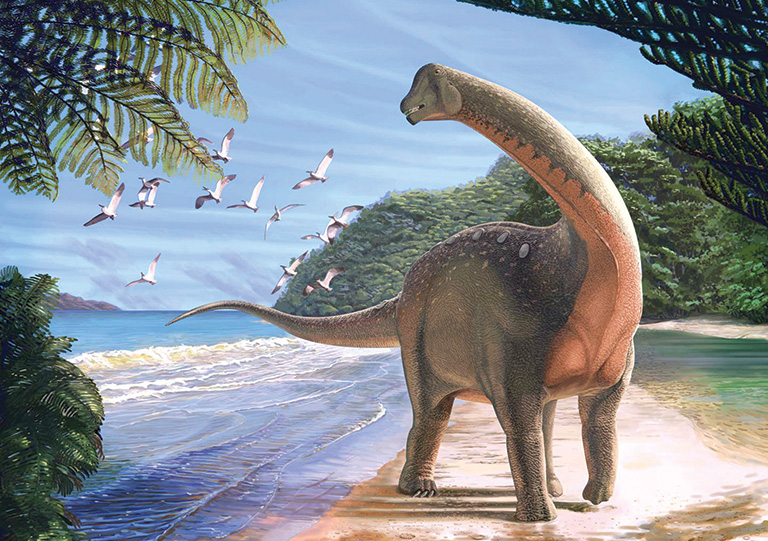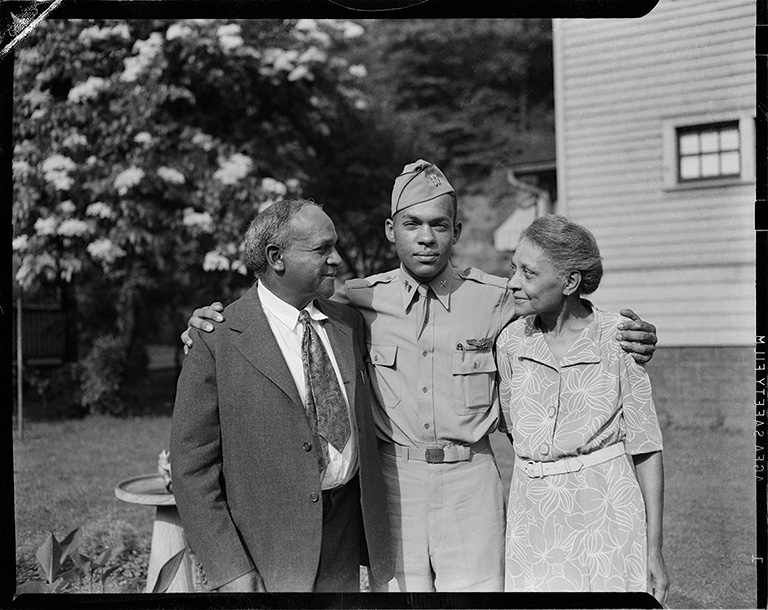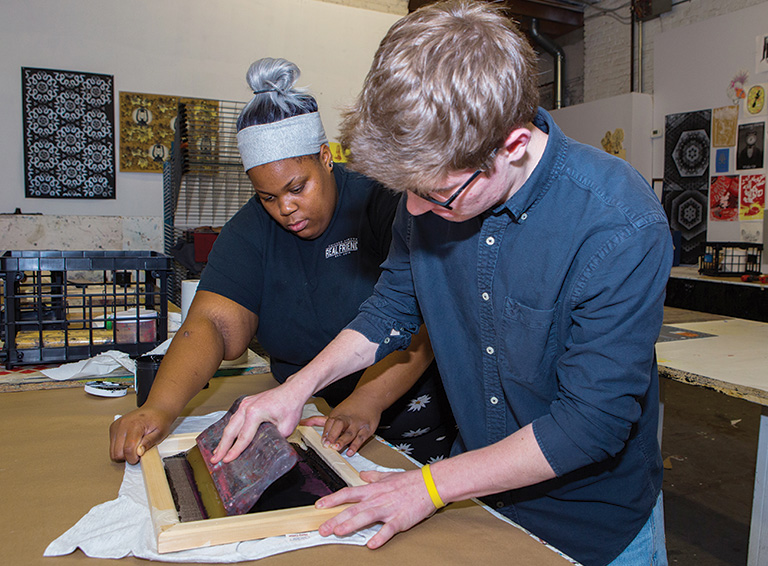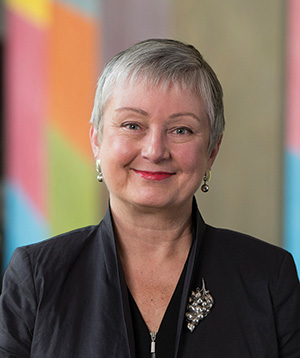A dinosaur dream come true

Life reconstruction of Mansourasaurus shahinae on a coastline of what is now the Western Desert of Egypt about 80 million years ago. Illustration: Andrew McAfee
It was the length of a school bus and lived in what’s now modern-day Egypt. And it’s giving paleontologists rare insight into a time and place they know little about: the final chapter of the age of dinosaurs in Africa. “When I first saw the fossils, my jaw hit the floor,” says Matt Lamanna, chief dinosaur hunter at Carnegie Museum of Natural History and co-author of the study that describes the new dinosaur species Mansourasaurus shahinae, published this January in the journal Nature Ecology and Evolution. “This was the Holy Grail that we paleontologists had been searching for for a long, long time. The dinosaur I’d dreamed about for virtually all of my professional life had finally been found!”
Paleontologists at Mansoura University in Egypt discovered the fairly complete skeleton in the Sahara Desert in 2013. Lamanna, an expert in Southern Hemisphere dinosaurs who in 2000 helped to unearth one of the world’s largest land animals in Egypt, was part of a team of researchers that analyzed its bones. Though Africa is well-known for human fossils, its dinosaur record during the Late Cretaceous, 100 to 66 million years ago, is sparse. During this time period, the continents completed their shift from a single giant landmass to generally where they are today. The question long dogging scientists, including Lamanna, has been to what degree Africa’s animals may have been cut off from their neighbors. Mansourasaurus—whose name is a nod to both Mansoura University and a champion of its vertebrate paleontology program, Mona Shahin—now provides some significant clues. Rigorous analysis shows, Lamanna says, “that at least some African Late Cretaceous dinosaurs weren’t island-dwelling weirdos after all—rather, they had close cousins in Europe.”
 Giving students a head start
Giving students a head start
Some Pittsburgh early learners are getting a very special head start, thanks to a $200,000 grant from The Heinz Endowments. This fall, Carnegie Science Center will deepen its longstanding relationship with Pittsburgh Public Schools Early Childhood Program by opening a Head Start classroom on-site. It’s a game changer for preschoolers, says Jason Brown, the Science Center’s senior director of science and education. “Not only will we continue to work with Pittsburgh Public Schools to provide a quality, robust science curriculum, but now these educators and students will have ready access to a giant sandbox to supplement that curriculum,” says Brown, referencing the Science Center’s many hands-on exhibits and activities. “To my knowledge, no school has a science facility or materials like we have here at the Science Center.”
“When loyalties to my heritage and my veteran status threaten to tear me apart, I am empowered by the perseverance and triumphs of black patriots who served before me.”
– Former Staff Sergeant Lance A. Woods, guest curator for Teenie Harris Photographs: Service and Sacrifice on view through May 28 at Carnegie Museum of Art.

Charles “Teenie” Harris, Tuskegee Airman James T. Wiley posed with arms around man wearing paisley tie and woman wearing floral dress, possibly his parents, June 1944, Carnegie Museum of Art, Heinz Family Fund
Diversifying the museum ranks

Studies show leadership at U.S. cultural institutions doesn’t reflect the demographics of the country. Only 16 percent of art museum leadership positions are held by people of color, even though 38 percent of Americans identify as Asian, Black, Hispanic, or multiracial. So how does change happen? Carnegie Museums has committed to diversity and inclusion in its programming and services, and in how it grooms and hires new talent. A major boost to these efforts: This past November, The Andy Warhol Museum was one of 20 museums nationwide awarded a multiyear grant by The Ford Foundation and the Walton Family Foundation as part of their Diversifying Art Museum Leadership Initiative. The Warhol will receive $265,000 over three years to support its efforts to diversify its curatorial and management staff.
The Warhol is building on its innovative teen programming that brings in Pittsburgh youth who otherwise would have few opportunities to engage with museums. In some cases, the teens can advance to paid internships and then full-time employment.
“This funding is the start of reimagining the museum’s education and outreach initiatives not just as fostering arts engagement and creative expression across our community, but as helping to develop a diverse new generation of museum leaders,” says Danielle Linzer, the museum’s director of learning and public engagement.
“The initiative perfectly aligns with The Warhol’s mission to enlighten and inspire through Warhol’s life and art,” adds Patrick Moore, director of The Warhol. “Young people who, like Andy, do not come from privileged backgrounds will be given the opportunity to build skills and careers in the very institution dedicated to his legacy. The Warhol, the Pittsburgh community, and the entire museum field will be richer for supporting these promising young people.”

That’s the current number of Carnegie Museums member households—a new record!
Carnegie Museums president steps down
 Jo Ellen Parker, the first female president and CEO of Carnegie Museums, stepped down from her post in February. “I’m proud of what we have accomplished over the past four years-initiatives that collectively have made Carnegie Museums a stronger and more effective organization,” Parker said in a note to staff.
Jo Ellen Parker, the first female president and CEO of Carnegie Museums, stepped down from her post in February. “I’m proud of what we have accomplished over the past four years-initiatives that collectively have made Carnegie Museums a stronger and more effective organization,” Parker said in a note to staff.
“It’s been an honor working with Jo Ellen, who has led Carnegie Museums through a period of growth and innovation,” says Bill Hunt, chair of the Carnegie Museums board of trustees. “During her tenure, she made valued contributions to organizational structure and governance, financial sustainability, accessibility, and building more inclusive museums. She also spearheaded the creation
of the Innovation Studio, which is dedicated to helping the museums integrate digital technologies; the office of the Diversity Catalyst, which supports social inclusion in all aspects of the museums’ work; and the cross-disciplinary Carnegie Nexus initiative, which offers ‘beyond the galleries’ experiences and programs on issues of pressing current interest.”
Hunt and executive vice president and chief operating officer Kevin Hiles are leading an operating committee of museum leaders providing interim leadership during the search for a new Carnegie Museums president.



